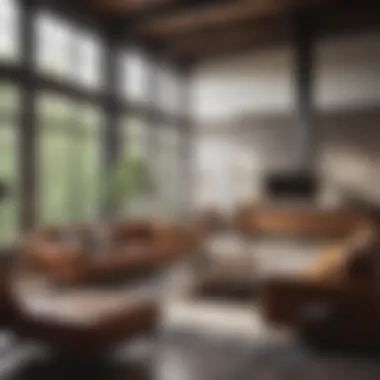Exploring Aesthetic and Functional Design in Living Spaces


Intro
The design of living spaces is a critical element of our daily experiences. From the homes we inhabit to the communal areas we share, the approach to design shapes how we interact with our environment and with one another. This exploration seeks to uncover the intricate relationship between aesthetic values and practical applications within common living spaces.
By examining various environments, readers will discover that thoughtful design is not merely about making areas visually appealing. It extends to how these spaces serve functional purposes and accommodate the needs of their inhabitants. The emotional and sociocultural influences of design principles also play a role in shaping our lives. We will analyze architectural styles and current decor trends, shedding light on how they reflect broader cultural contexts.
This article brings together insights aiming to appeal to homeowners, designers, and all who have an interest in architecture. The combination of beauty and utility in design is central to the enhancement of everyday life. Let's begin with a close look at how inspiration can be drawn from various home designs.
Understanding Common Living Spaces
Understanding common living spaces is pivotal in recognizing how they shape our daily lives. The way in which these spaces are designed directly impacts both functionality and aesthetics. Properly understanding these elements leads to enhanced quality of life, allowing individuals to feel more comfortable and connected to their environment. Like specific ingredients in a recipe, each component in these living spaces plays a crucial role in achieving a harmonious result.
Definition and Scope
Common living spaces encompass a variety of environments where people interact and dwell. This term includes residential homes, shared living environments, and public spaces. Residential homes, such as single-family houses or multi-family units, form the primary domain for many individuals. Shared living environments like co-housing or student accommodations are growing in popularity, driven by social trends and economic factors. Public living spaces, including parks and community centers, provide essential areas for social interaction and leisure activities.
The scope of this topic extends beyond physical attributes. The layout, design, and functionality of these spaces influence not just how we use them, but also how they make us feel. Each space serves as a canvas for human experience, affected by both personal preferences and cultural contexts.
Cultural Perspectives on Living Spaces
Culture plays a significant role in shaping our understanding of living spaces. Different cultures have distinct ways of organizing and using their environments. For instance, in some cultures, homes are centered around communal living, while in others, privacy within the home is of utmost importance.
- Traditional Approaches: Many traditional homes reflect historical lifestyles. They are often designed to accommodate large families, highlighting the importance of multi-generational living. Such structures may prioritize common areas for gathering, promoting social interaction.
- Modern Influences: Contemporary designs often favor minimalism and open floor plans, reflecting a shift toward multifunctional spaces. These environments may prioritize flexibility and adaptability, enabling easier adjustments to individual needs.
- Regional Variations: Climate and geography influence living space designs. In hotter regions, homes may feature shaded patios and cross-ventilation designs, while colder regions may have compact structures designed for insulation.
Design choices are not just aesthetic but also communicate social values and priorities. Thus, understanding cultural perspectives allows for a richer appreciation of how living spaces function and resonate across diverse societies.
"The design of living spaces is a reflection of the cultural values and lifestyles of their inhabitants."
In exploring common living spaces, one can appreciate the delicate interplay between architecture and human experience. This knowledge enhances our understanding of how design choices impact interactions, community building, and individual well-being.
Types of Common Living Spaces
Understanding the different types of common living spaces is crucial for grasping how environments influence lifestyle. Each type offers distinct characteristics and benefits. Exploring these spaces can help designers and residents appreciate the thoughtful integration of form and function. This section highlights residential, shared, and public living spaces, ensuring a comprehensive examination of how each type serves its purpose in the modern world.
Residential Homes
Single-Family Homes
Single-family homes stand as a staple in residential living. This setup allows an individual or family to occupy the whole property. It provides privacy and autonomy. Many choose this option for the personal space it affords. A key characteristic of single-family homes is the presence of yard space. This feature encourages outdoor activities and gardening, linking residents to nature.
However, with greater space comes the challenge of maintenance. Homeowners are responsible for upkeep, which can be demanding. Yet, the benefits often outweigh such concerns, making single-family homes a sought-after choice in real estate.
Multi-Family Units
Multi-family units cater to a diverse range of residents, offering many housing choices within a single building or complex. This type of living space includes apartments and duplexes. A defining feature of multi-family units is their ability to accommodate multiple families, making them economically advantageous. Many people opt for these spaces for affordability, often enjoying shared amenities such as pools and gyms.
Nonetheless, the communal aspect can present challenges. Noise and lack of privacy may become concerns. Still, multi-family units remain popular, allowing for community engagement and support among residents.
Condos and Townhouses
Condos and townhouses provide a balance between single-family homes and multi-family units. They typically share walls with neighbors while offering a sense of ownership. A unique feature of these spaces is the community atmosphere coupled with personal property. This makes owning a condo or townhouse attractive for those desiring less maintenance than single-family homes.
However, ownership comes with homeowners' association fees, which can be a downside. Even so, the ability to live in vibrant communities with amenities often offsets this cost, enhancing their appeal.


Shared Living Environments
Co-Housing
Co-housing structures encourage collaboration among residents. This setup emphasizes sharing common spaces while maintaining private living quarters. A significant characteristic is the shared kitchen and communal gardens, fostering a strong sense of community. This arrangement appeals to those seeking social interaction and a cooperative lifestyle.
While sharing can lead to conflicts, effective communication often resolves these issues, leading to a supportive network. The benefits of co-housing extend to sustainability, as residents often engage in collective decision-making regarding resource use and maintenance.
Roommate Situations
Roommate arrangements create opportunities for individuals to share living expenses. This option is particularly popular among young professionals and students. The key characteristic of roommate situations is affordability, allowing individuals to live in areas they otherwise couldn't afford. Such arrangements can also cultivate friendships and a sense of belonging.
However, challenges may arise from differences in lifestyle and habits. Successful roommate situations require clear communication and respect. When managed well, the benefits often enhance one's social and financial well-being.
Student Housing
Student housing focuses on providing accommodations for college and university students. This type includes dormitories and off-campus apartments. A defining feature is its proximity to educational institutions, making it convenient for residents. The communal living experience often nurtures friendships and networking opportunities.
Nevertheless, student housing may lack privacy and quiet, which some students may find challenging. Understanding this environment's dynamics can lead to a rewarding living arrangement.
Public Living Spaces
Parks and Recreational Areas
Parks and recreational areas serve as vital public living spaces. They promote physical activity and mental well-being, providing a respite from urban life. A fundamental characteristic of these spaces is accessibility, encouraging community interaction and leisure. Gathering spaces like picnic areas and playgrounds enhance connection among residents.
However, funding and maintenance can become issues, occasionally limiting the quality of these spaces. Despite these challenges, parks remain crucial for community health and cohesion.
Community Centers
Community centers play a pivotal role in fostering social connections. They offer various programs and services to residents of all ages. A key feature of community centers is diversity, accommodating numerous activities from fitness classes to art workshops. Such versatility makes them invaluable to neighborhood dynamics.
On the downside, the effectiveness of community centers can vary based on local support and funding. Still, when fully utilized, they can enrich community life significantly.
Shopping Malls
Shopping malls are essential public living spaces, serving as commercial hubs. They provide shopping, dining, and entertainment options, attracting diverse visitors. A unique characteristic is the blending of social and commercial activities, as malls often host events that draw communities together.
However, the rise of online shopping has challenged traditional malls, prompting many to adapt to changing consumer behavior. Balancing retail and experiential opportunities is crucial for their continued relevance. Malls that successfully integrate various activities can remain vibrant centers of community life.
Design Principles in Living Spaces
The design principles in living spaces play a crucial role in enhancing both aesthetics and functionality. These principles guide architects and designers in creating environments that not only look good but also serve the needs of the residents effectively. Understanding these principles helps in achieving a balance between beauty and purpose, making living spaces more enjoyable and usable.
Functional Layouts
Open Floor Plans
Open floor plans eliminate unnecessary walls to create a seamless flow between different areas. This layout encourages interaction and connectivity among spaces. It is known for making areas feel more spacious, which can be particularly beneficial in smaller homes. However, while open floor plans facilitate socialization, they may also lead to noise distractions and less privacy.
Zoning Techniques
Zoning techniques provide a method to organize living spaces into distinct areas for specific functions. This design principle is beneficial in balancing privacy with social interaction. For instance, a home may feature a quiet reading nook separate from a lively living room. While zoning can improve functionality, it requires careful design to ensure that spaces do not feel isolated.
Furniture Arrangement


The arrangement of furniture significantly influences the dynamics of a living space. Well-planned furniture layouts can promote better traffic flow and usability. Proper arrangement can highlight focal points, such as fireplaces or artwork, enhancing the overall aesthetic. However, limited space can restrict furniture options, requiring creative solutions to optimize flow and comfort.
Aesthetic Considerations
Color Schemes
Color schemes contribute to the mood and atmosphere of living environments. Thoughtful color choices can make a space feel inviting and warm or calm and serene. Neutral tones are popular for their versatility, while bold colors might offer a stimulating contrast. However, an overwhelming use of bright colors can become visually tiring in a long run.
Material Selection
Selecting the right materials is essential for achieving both visual appeal and durability. Materials like wood and stone can add warmth and texture to a space, while metal and glass may create a modern feel. Each material has its own pros and cons regarding maintenance, cost, and aesthetic impact. The key is to ensure that materials used harmonize with the entire design concept.
Lighting Design
Lighting design is vital in shaping the ambiance of living spaces. Effective lighting enhances both functionality and aesthetics. Layered lighting, which includes ambient, task, and accent lighting, allows for flexibility and adaptability in use. Poor lighting can lead to discomfort and diminish the beauty of carefully chosen decor.
Sustainable Practices
Energy Efficiency
Prioritizing energy efficiency in design aims to reduce consumption and promote sustainability. Elements such as proper insulation, energy-efficient appliances, and natural heating solutions contribute to long-term cost savings. While implementing these features can require higher initial investments, the long-term benefits often outweigh the costs.
Use of Recycled Materials
Using recycled materials is a growing trend in sustainable design. This practice reduces waste and often involves unique items that add character to a space. Choosing recycled materials may pose challenges like limited availability or higher costs, but the positive environmental impact can be a strong motivator.
Indoor Air Quality
Ensuring good indoor air quality is essential for health and well-being. Proper ventilation and the use of non-toxic materials can lead to a healthier living environment. While some strategies may seem complex, investing in air quality can result in a more comfortable and safe home over time.
Psychological and Sociocultural Impacts
Understanding the psychological and sociocultural impacts of living spaces is crucial in designing environments that enhance the quality of life. This aspect engages several elements, including emotional well-being, social interaction, and personal privacy. Each of these factors plays a significant role in how individuals connect with their surroundings and with each other. The effects of living spaces on mental health cannot be overstated. Architecturally sound designs lead to improved mood, increased satisfaction, and a stronger sense of community. By examining these impacts, we can appreciate the profound connection between space and its inhabitants.
Effects on Well-Being
Emotional Responses to Space
Emotional responses to space are intrinsic to how we perceive our living environments. Certain design elements can evoke feelings of comfort and security. For example, natural light and open spaces are often associated with positive emotions. These characteristics make emotional responses a powerful aspect of design. They allow for a beneficial atmosphere, enhancing occupants' overall experience in their living areas.
A notable feature of this concept is the relationship between color and mood. Warm colors, like yellows and reds, can stimulate feelings of warmth and energy, while cool tones promote calmness and relaxation. However, the challenge lies in striking the right balance; too much of an intense color can lead to overwhelming emotions.
Social Interaction and Community Building
Social interaction is fundamentally shaped by the design of living spaces. Layouts that encourage gatherings, such as community kitchens or shared lounge areas, foster a sense of belonging. These spaces become crucial for community building, providing opportunities for residents to connect.
One notable aspect is the need for inclusivity. Designs that cater to diverse groups can enhance social networks. However, while communal areas promote interaction, they must also consider personal space needs, as a lack of privacy can negatively impact social dynamics.
Privacy and Personal Space
Privacy is a vital component of living spaces, directly affecting well-being. Individuals require personal space to recharge and maintain mental health. The importance of designing areas that allow for solitude cannot be overlooked. This principle produces spaces that meet the needs of individuals while promoting an overall balanced environment.
Notably, access to private areas is essential for self-reflection and quiet time. The challenge is creating spaces that provide solitude while avoiding isolation. This balance is crucial for both emotional health and community cohesion.


Cultural Influences on Design Choices
Traditional vs. Modern Approaches
Design choices often reflect a dichotomy between traditional and modern approaches. Traditional designs, based on historical context, often prioritize functionality and cultural heritage. They resonate with community identity and can evoke nostalgia. These styles often include elements like intricate woodwork and specific spatial arrangements that foster interaction.
On the other hand, modern designs emphasize minimalism and functionality. They often feature open spaces aimed at flexibility and efficiency. Each approach offers distinct advantages, where traditional styles provide a strong sense of identity and modern approaches facilitate innovation and adaptability.
Regional Variations
Regional variations highlight how geography influences design choices. Certain areas develop unique characteristics shaped by local culture, climate, and available materials. For instance, coastal designs may integrate large windows to capture seascapes, while mountainous regions might focus on sturdy, insulated structures to combat cold.
This divergence contributes richness to architectural styles but can pose challenges for consistency. Designers need to balance local relevance with broader trends, ensuring that spaces are both practical and contextually appropriate.
Iconic Architectural Styles
Iconic architectural styles have enduring impacts on living spaces. These styles, from Gothic to contemporary, define not only the aesthetic value of regions but also the functionality of spaces. Recognizing iconic designs can inspire innovation in new projects while honoring historical significance.
Each style carries unique characteristics and reflects the sociocultural context of its time. However, designers must remain aware of how these styles can affect modern living, especially in accommodating contemporary needs alongside historical features.
Future Trends in Living Spaces
The concept of living spaces is evolving rapidly. Understanding future trends is critical for homeowners, designers, and enthusiasts of contemporary design. It highlights the need for adaptability, technology, and the emphasis on sustainability in living environments. As society changes, so do the demands placed on living spaces. Hence, we will explore smart home integrations and adaptation to shifting needs, demonstrating how these elements contribute positively to the future of living spaces.
Smart Home Integration
Automation Technologies
Automation technologies represent a significant advancement in living space design. This aspect comprises devices that simplify daily tasks through automation. Key characteristics include voice control, sensors, and app connectivity. These features allow users to manage home systems efficiently. Smart thermostats and lighting systems offer convenience and energy savings. A unique feature of automation technologies is their capacity to integrate various devices into a connected ecosystem. However, challenges include ensuring security and privacy in connected devices.
Safety and Security Enhancements
Safety and security enhancements are paramount in modern living spaces. These solutions often include smart locks, surveillance cameras, and alarm systems. Their main characteristic is remote monitoring. A significant benefit is the peace of mind given to residents. These devices can deter crime, which is increasingly important for urban living. Unique features may include facial recognition and smartphone alerts. Nevertheless, reliance on technology also means potential vulnerabilities if systems are hacked.
Energy Management Systems
Energy management systems focus on optimizing energy efficiency. Such systems track energy usage and suggest ways to reduce consumption. The essential characteristic of these systems is real-time monitoring. They assist homeowners in making informed decisions about energy use. An advantage is the potential reduction in utility bills and a lower carbon footprint. Unique features often involve smart grid technology integration. However, initial investment costs can be a barrier for some homeowners.
Adaptation to Changing Needs
Flexible Spaces
Flexible spaces in living areas allow for multi-functional usage. These spaces can be transformed based on the homeowner's needs. This adaptability is a vital characteristic that appeals to modern families and individuals. Flexibility in design promotes creativity and efficiency in space utilization. Unique features often include movable walls and modular furniture. The disadvantage may include the challenges of creating a harmonious design while maintaining functionality.
Multi-Generational Living Solutions
Multi-generational living solutions address the increasing trend of families living together. This setup provides support and nurtures familial bonds. Key characteristics include separate living spaces and shared common areas. A significant benefit is the reduction of housing costs for all generations involved. Unique features may involve suites with independent entrances. Challenges could arise in balancing privacy with shared space responsibilities.
Home Offices in Design
Home offices have emerged as essential elements in living space design, especially post-pandemic. Their key characteristic is the provision of dedicated workspaces at home. Increasing flexibility in work arrangements enhances their desirability. A unique feature of home offices may include ergonomic design elements and soundproofing. However, maintaining productivity in a home environment can be challenging without clear boundaries.
Culmination
The discussion surrounding common living spaces reveals a multidimensional context that blends aesthetics with functionality. Each element of design plays a crucial role in shaping both individual and communal experiences. These spaces are more than just physical structures; they embody cultural narratives, social interactions, and practical needs.
Design principles relevant to living spaces are significant for several reasons. First, understanding these principles allows homeowners and designers to make informed choices. For example, an open floor plan can facilitate better social interactions among family members, while dedicated workspaces cater to increased remote working needs.
Secondly, the psychological impact of living environments demands attention. How individuals respond emotionally to their surroundings influences well-being. Spaces designed with mindfulness can reduce stress and foster creativity. This underscores the necessity to balance form and function.
Moreover, the integration of technology continues to reshape living spaces. As smart home systems proliferate, understanding their benefits and potential drawbacks becomes essential to optimize usability. The design choices individuals and communities make today will pave the way for future living environments.





